Cat Anxiety: Signs, Causes and Treatments
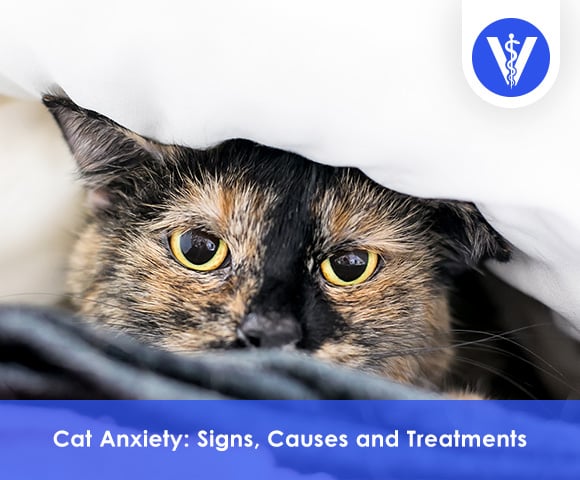
Table of Contents
Cat anxiety is fearful anticipation of impending danger, whether real or imagined. All animals experience moderate anxiety, but severe cat anxiety has disruptive or even destructive effects and lowers the cat’s quality of life.
Cat anxiety symptoms include increased meowing, yowling, crouching, hiding, aggressiveness or clinginess, destructive tendencies, avoiding the litter box, and excessive grooming. Body language, such as avoiding eye contact, dilated pupils, and tail flicking, are signs of anxiety in cats.
A combination of genetic factors, environmental conditions, and experiences causes anxiety in cats. Frequent anxiety triggers are alone time, habitat changes, improper socialization, pain, and illness.
Treating cat anxiety is a multimodal approach entailing behavior modification techniques, anti-anxiety medications, natural supplements, and alternative calming approaches. A universal cure for cat anxiety does not exist, and it takes time to determine what works best for the specific cat.
Owners are able to keep cats calm by learning to read the cat’s body language, ensuring a safe environment, and providing plenty of physical and mental stimulation. Using calming medications and supplements helps calm a nervous cat. Socializing the cat and building confidence prevent stress episodes in the long term.
What is Cat Anxiety?
Cat anxiety is when a cat anticipates a threat or danger, making it react in unusual ways. Threats or dangers include other cats, unfamiliar situations, medical problems, moving home, separation from the owner, a change in routine, boredom, loud noises, and improper socialization. The threat or danger is not always real and objective, but the cat expects something traumatic to happen.
Dogs have higher rates of anxiety than cats. Cat anxiety is underdiagnosed as cats are excellent at hiding signs of distress. Anxiety is frustrating and debilitating, with consequences ranging from disruptive to destructive.
A nervous cat displays bodily reactions and behavioral changes. PetMD says that “many fears, phobias, and anxieties develop as a result of experiences in the first year of a cat’s life.”
Cat anxiety is an umbrella term for fear and stress. Fear and stress in cats are different from anxiety. Fear in cats is a graded response whose intensity depends on the trigger’s closeness. Fear is a behavior related to escape and avoidance. Stress is an ongoing state of unease.
Creating low-level anxiety and fear helps cats adjust and normalize behavior in nervous cats. High-level anxiety and stress are always negative and maladaptive. The anxious cat’s response to the stress trigger is disproportional to its potential danger, which affects life quality.
What are the Signs of Anxiety for Cats?
The signs of anxiety in cats are listed below.
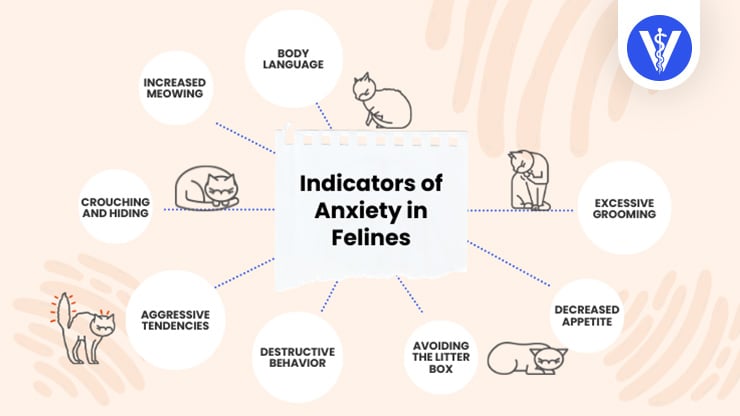
- Body Language: Physical or body language cat anxiety symptoms include avoiding eye contact, dilated pupils, nervous tail flicking, shifting body and head away, holding the ears back, and erecting hair, especially on the back.
- Increased Meowing: Increased vocalization is a frequent anxiety sign in cats. Meows from anxious cats differ in frequency, duration, intensity, and contours. A 2019 study, “Melody Matters: An acoustic study of domestic cat meows in six contexts and four mental states,” demonstrated that cats use “paralinguistic information to signal mental state.”
- Crouching and Hiding: Crouching is a sign of fear in cats. Anxious cats crouch when exposed to stress triggers and try to escape and hide in a safe place. Hiding is a sign of anxiety in cats.
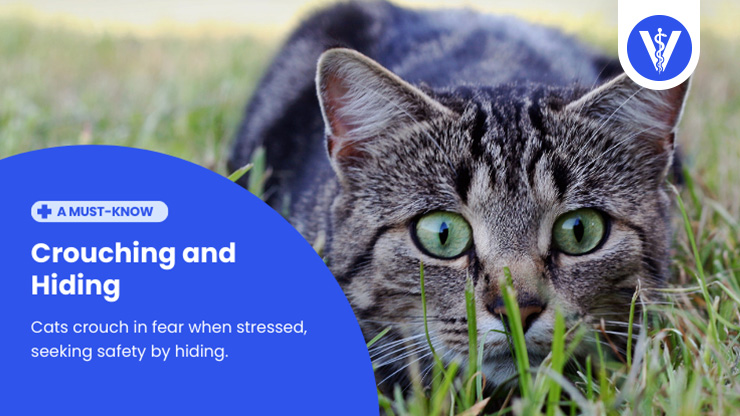
- Aggressive Tendencies: Cats in distress are more aggressive. Cats with anxiety are irritable, hiss for no apparent reason, and attempt to attack the source of anxiety.
- Clinginess: Anxious cats that are not aggressive become overly attached to owners. Cats follow the owner around the house and are needy, requiring attention and petting.
- Destructive Behavior: Scratching the door frames, chewing pillows, and digging in plant pots are destructive habits associated with anxiety. Destructiveness is an anxiety red flag in otherwise calm and well-behaved cats. The 2020 paper, “Identification of separation-related problems in domestic cats: A questionnaire survey,” stated destructive behavior is the most common symptom in cats with separation anxiety.
- Avoiding the Litter Box: Peeing and defecating outside the litter box is a common sign of anxiety in potty-trained cats. A 2002 retrospective study, “Separation anxiety syndrome in cats: 136 cases (1991-2000),” found that “seventy-five percent of the cats that urinated inappropriately urinated exclusively on the owner’s bed.” The study found inappropriate defecation is significantly more common in females than in males.
- Decreased Appetite: Anxiety has a significant impact on food intake, and many cats, when stressed, refuse to eat. Appetite changes are hard to notice in felines, particularly cats with picky taste preferences.
- Excessive Grooming: Self-grooming is a coping mechanism in pets and anxious cats groom obsessively, medically known as psychogenic grooming. Excessive licking causes skin and coat damage, irritation, and bald patches.
What are the Causes of Cat Anxiety?
The causes of cat anxiety are listed below.
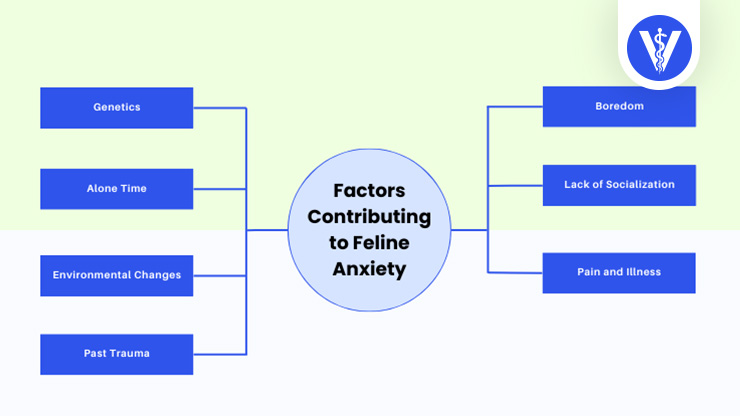
- Genetics: The cat’s genetic makeup plays a vital role in the development of anxiety, as shown in a 2013 study, “Genetic factors in anxiety disorders” by Katharina Domschke and Eduard Maron. The anxiety risk is higher among cat breeds, such as Tonkinese and Burmese.
- Alone Time: Being left alone, especially for a long time, is a common cause of stress in cats. Separation anxiety occurs frequently in cats that have switched multiple families in the past and cats that have been abused. Cats bond with one family member the most and are anxious when that person is absent.
- Environmental Changes: Cats are sensitive to changes in daily routines and living environments. Potential stressors range from small changes like rearranging the furniture or getting a new cat litter to big alternations like switching houses and bringing in a new family member, human or animal.
- Past Trauma: Traumatic events affect the cat’s emotional state and result in stress over time. Abandonment, neglect, and abuse are severe traumas, increasing the risk of cat anxiety. Cats saved from the street or adopted from shelters are likely to carry trauma that evolves into anxiety.
- Boredom: Insufficient physical and mental challenges are widespread causes of cat anxiety. Wild cats engage in physically and mentally stimulating predatory activities to survive. The domestic cat, especially if living strictly indoors, lacks opportunity for stimulation, which causes boredom and then anxiety.
- Lack of Socialization: Improper socialization during kittenhood triggers anxiety in some adult cats. Cats, although not as social as dogs, need extensive and early socialization. Kittens must be socialized between two and nine weeks of age.
- Pain and Illness: Pain, discomfort, and illness are frequent causes of anxiety in cats. Cats are predators and feel vulnerable and alert when in pain or sick. Common medical conditions linked to cat anxiety are stomach upsets, paw injuries, and arthritis.
How can Cat Anxiety be Treated?
Cat anxiety can be treated using management options, calming aids, anxiety medications, behavior modification, or any combination of these approaches.
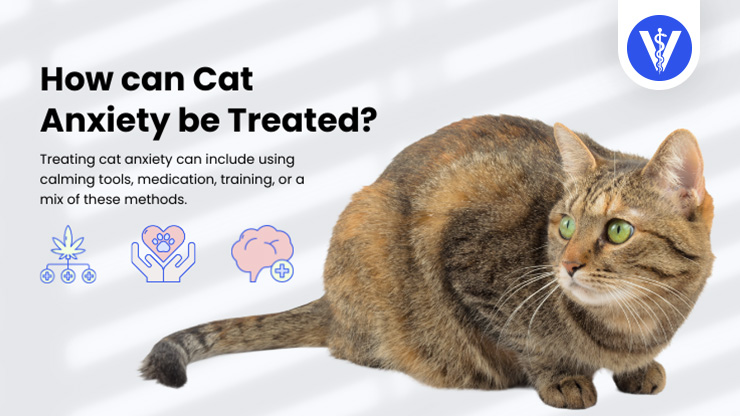
Anxiety management includes identifying the stress trigger and eliminating or at least minimizing its presence. Avoiding stressful situations is the simplest way to treat anxiety, but it is not always possible.
Calming aids are natural supplements and alternative treatments that help relieve anxiety and promote relaxation. Common options include pheromone sprays, thundershirts for cats, PEMF therapy, music therapy, probiotics, and supplements featuring calming ingredients like CBD, passion flower, or B-complex vitamins.
Anxiety medications alter the brain chemistry, relieve stress, and increase calmness. Drugs are used in severe cases and must be prescribed by a licensed veterinarian. Never give cats over-the-counter anxiety drugs for humans without a veterinarian’s approval.
Cat anxiety is treated with short-term and long-term medication. Commonly used medications for cats with anxiety are fluoxetine, paroxetine, sertraline, clomipramine, trazodone, buspirone, alprazolam, oxazepam, lorazepam, and gabapentin.
Behavior modification is the best cat anxiety treatment, but takes time. Behavior modification is effective when used in conjunction with calming supplements and medications. Behavior modification entails various techniques, such as counterconditioning and desensitization.
Counterconditioning focuses on replacing the cat’s negative perception of the stressful stimuli with a pleasant experience. Desensitization is based on gradual exposure to low-level triggers until the cat gets used to their presence.
What can Owners do to Keep their Cat Calm?
Owners can give space, talk softly, play games, or use anti-anxiety medication and supplements to keep their cat calm.
Providing a safe space is paramount when managing an anxious pet. Living spaces range from small boxes to entire rooms, depending on the situation. The ideal safe spot is in a darkened and noise-free place. Cats must not be disturbed while retreating in a safe place.
Having a cardboard box and being a safe spot provides environmental enrichment for cats and helps soothe anxiety. A 2014 study, “Environmental Enrichment: A Cat`s Preferences” by Kellie Thomas, found that 70% of cats prefer cardboard boxes over cat beds, laundry baskets, and towels and chose boxes in seven out of ten trials.
Talking to cats using a gentle voice helps support calmness. Animal Cognition published a paper in 2022 titled “Discrimination of cat-directed speech from human-directed speech in a population of indoor companion cats (Felis catus).” The study concluded that cats react to baby talk from owners but are indifferent when coming from strangers. The owner’s baby-talk voice is calming for cats.
Playing games has anti-anxiety potential, too. Interactive games and enrichment toys provide physical and mental stimulation for cats. Engaging in active play keeps the body and mind occupied and takes the focus away from the stress trigger.
Anti-anxiety supplements and medications are very effective in keeping cats calm. Pheromones and CBD products are the most popular and easily available alternative options. Anti-anxiety drugs require a veterinary subscription and are used for severe cases in cats that do not respond to other calming methods.
How can the Veterinarians Diagnose Cats’ Anxiety?
Veterinarians diagnose cat anxiety based on clinical signs. There is no specific test for anxiety in cats, and the veterinarian makes a diagnosis after evaluating the cat’s behavior and ruling out other conditions like medical issues contributing to the situation.
The veterinarian takes the cat’s thorough history. Owners providing a specific and detailed history see better results. Filming the cat during its anxiety episode and showing the video to the veterinarian is helpful.
The veterinarian completes a physical assessment. The physical assessment is a full body examination and basic tests such as bloodwork and urine analysis or more advanced tests like radiographs or ultrasounds based on the initial findings.
How does Environment Trigger the Cats’ Anxiety?
Environment triggers cat anxiety by altering the strong feline environmental sensitivity or orientation. Cats evolved as reclusive hunters, stalking prey from a safe and advantageous distance. The high environmental orientation or sensitivity makes cats anxious when faced with habitat changes.
Modern cats maintain wild, predatory instincts and are naturally attuned to their surroundings and perceptive even to the smallest discrepancies. Anxiety in cats is triggered by environmental changes ranging from something as small as a simple furniture rearrangement or switching to a new type of cat litter to something as big as adding a new pet to the household or moving to a new house.
Cats with anxiety increase yowling hiding, have dilated pupils, and are highly alert.
What are Ways you can do to your Cat to Help with Environmental Anxiety?
The ways you can do to help your cat with environmental anxiety are listed below.
- Provide a Safe Space: Cats with anxiety need a safe space to retreat and feel safe when overwhelmed by stress. The safe space varies from a small card box in a quiet and darkened place to an entire room or part of the room filled with enriching cat toys, like perches, scratching posts, and climbing trees for cats.
- Manage the Litter Box: The litter box must be placed in the right spot and easily accessible. Avoid putting the box in corners where the cat feels trapped. Multi-level homes and multi-cat households need multiple litter boxes. Multi-pet households must have more litter boxes than cats. For example, two cats need three boxes, and three cats need four.
- Feed Cats Separately: Cats are more territorial during mealtime and feel vulnerable, so they need to be alone. Designate a feeding space for each cat and ensure other pets cannot access the spot.
- Initiate Exercise: Ensure plenty of physical and mental stimulation to help cats with environmental anxiety. Keeping the cat’s body and mind occupied shifts the focus from the stress source. Puzzle games, interactive feeders, scratching posts, cat shelves with a view, cat perches, and climbing trees are all physically and mentally challenging, thus managing anxiety.
How can Pheromone Spray Help the Cat Calm?
Pheromone spray helps the cat calm down by mimicking the cat’s facial pheromones, which make felines safe, secure, and relaxed.
Pheromones are communication chemicals similar to hormones but acting outside the body. Cats produce three types of pheromones, including facial, urine, and paw pheromones. Mother cats synthesize an additional pheromone, the cat-appeasing pheromone or CAP.
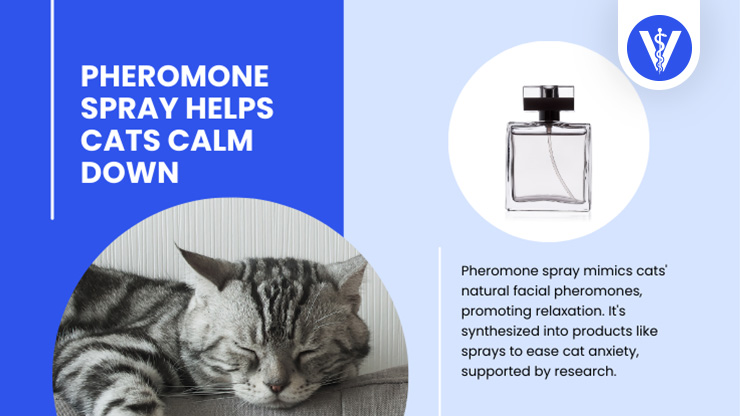
Facial pheromones (F3 and F4) send “happy messages,” saying the cat is well, and CAP makes kittens feel safe and well. Artificially synthesized F3, F4, and CAP are put into various products such as sprays, diffusers, and wipes and used to help ease cat anxiety and stress.
P. Pageat and E. Gaultier, in “Current research in canine and feline pheromones,” said, “Pheromonotherapy is a new therapeutic approach for treating behavioral disorders in pets, including cats, by reducing stress.”
Studies show that pheromones help cats calm down in unfamiliar surroundings and cats with transport-related stress.
Can CBD Oil Treat Cats’ Anxiety?
Yes, CBD oil can treat cat anxiety. CBD promotes natural calmness and relaxation through the endocannabinoid system (ECS). The endocannabinoid system is a regulatory mechanism responsible for controlling vital body functions in mammals.
Neuropharmacology published a paper, “Endocannabinoids, cannabinoids and the regulation of anxiety,” in 2021. The paper’s authors state that cannabinoids “play a crucial role in regulating anxiety symptoms, with therapeutic potential for developing novel anxiolytics.”
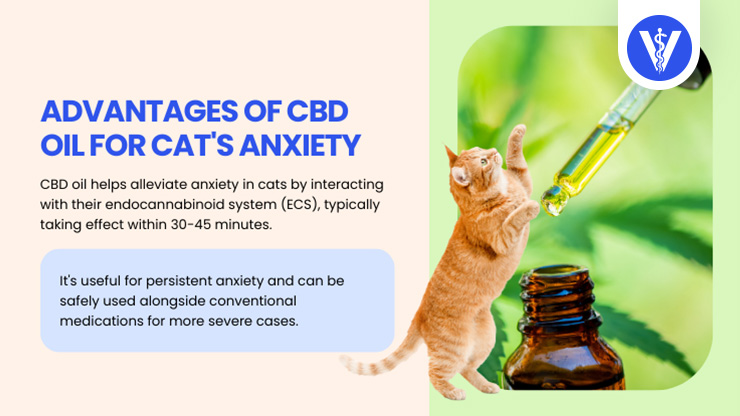
CBD or cannabidiol is a natural compound found in Cannabis sativa, more precisely in the hemp plant. CBD oil for cats is made by extracting the cannabinoids from hemp. The cannabinoids interact with the ECS, helping the anxious cat calm down.
The effects of CBD oils for cat anxiety are seen within 30 minutes to 45 minutes before the stressful event. Cats with ongoing anxiety benefit from regular daily use of CBD products, and in severe cases, CBD oil is safe to combine with mainstream anxiety medications.
What are the Properties of CBD Oil that Help with Cat Anxiety?
CBD oil has several properties that help with cat anxiety, including anti-stress, anxiolytic, panicolytic-like, antidepressant, and anticompulsive features.
Research in Veterinary Science published a paper in 2021, “Cannabidiol-based natural health products for companion animals: Recent advances in the management of anxiety, pain, and inflammation.” The study says, “There is a significant gap in the literature on the therapeutic use of CBD in cats, with no feline data on anxiety.”
The effects of CBD oil on cat anxiety are derived from other animal models and are expected in cats. Pet owners and veterinary reports confirm cats are expected to enjoy the same benefits from CBD oil.
Cannabinoids mimic the effects of the so-called “feel-good” hormone serotonin, which helps with anxiety relief. CBD eases learned fears, which contribute to phobias, anxiety, and post-traumatic stress disorders.
CBD oil has pain-controlling and dementia-relieving properties that help with cat anxiety control indirectly. Pain and dementia affect the cat’s life quality and fuel anxiety.
Frontiers in Veterinary Science, in the “A CBD/CBDA rich hemp paste showed potential in treating pain in cats, with no adverse events related to neurological function or behavioral alterations” paper from 2022 found that CBD “showed potential in treating pain in cats, with no adverse events.”
The Journal of Cannabis Research issued a study, “Feline cognitive dysfunction as a model for Alzheimer’s disease in the research of CBD as a potential treatment—a narrative review,” in 2020, stating, “CBD is a promising agent that may improve the life of cats with dementia.”
What are the Benefits of CBD Oil for Cats?
The benefits of CBD oil for cat anxiety are listed below.
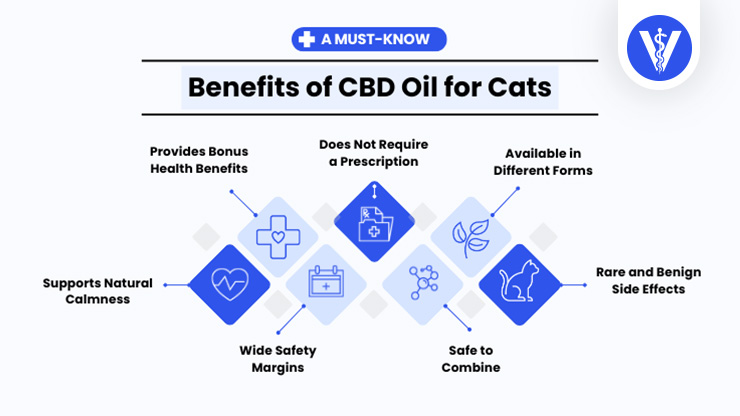
- Supports Natural Calmness: CBD promotes calmness and relaxation naturally through the cat’s endocannabinoid system. High-quality CBD products for cat anxiety are made with organic hemp, extracted with supercritical CO2, and free from artificial ingredients and additives.
- Wide Safety Margins: Hemp-based CBD for cats is all-natural and has a wide safety margin. CBD is safe for anxious cats of all ages and kittens over four months old. Animals cannot overdose on hemp-sourced CBD products.
- Safe to Combine: Cat CBD oil is safe to use as part of a multimodal treatment strategy and combined with mainstream anxiety medications and other calming methods, like counterconditioning and desensitization. Consult a veterinarian when using CBD in conjunction with cat anxiety drugs.
- Rare and Benign Side Effects: CBD for cats does not cause long-term, serious side effects. Cannabinoids, in some sensitive cats, trigger temporary and benign adverse events. The side effects of CBD resolve once the correct dose is determined and the cat gets used to the cannabinoids.
- Available in Different Forms: CBD products for cat anxiety come in different forms, including oils and treats. Cat CBD features pet-friendly flavors for easy use and is available in various strengths for simple dosing.
- Does Not Require a Prescription: CBD for cat anxiety is an over-the-counter (OTC) option and is easy to purchase online or in pet stores. CBD does not need a veterinary prescription, but it is recommended to consult a veterinarian before supplementing the cat.
- Provides Bonus Health Benefits: The benefits of CBD to animals go beyond anxiety management. CBD promotes natural wellness, boosts immunity, sharpens cognition, and aids the treatment of many conditions, like osteoarthritis, hyperactivity, allergies, kidney disease, seizures, and cancer.
What are the Side Effects of CBD Oil for Cats?
The side effects of CBD for dogs are listed below.
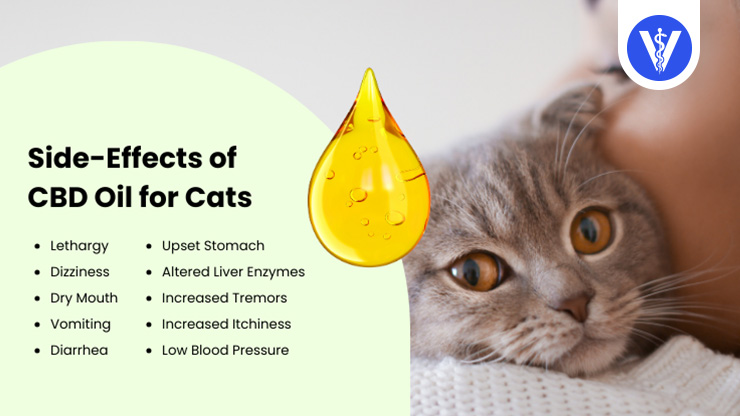
- Lethargy: Lethargy is a common side effect of CBD and manifests with low energy, increased sleepiness, and disinterest in daily activities.
- Dizziness: Dizziness results in loss of balance and coordination and is a rare adverse reaction linked with low-quality CBD products high in THC.
- Dry Mouth: Cannabinoids temporarily inhibit saliva production, causing dry mouth or xerostomia, which is highly uncomfortable for the cat.
- Vomiting: Vomiting is a widespread but self-limiting adverse effect that occurs in cats due to the cannabinoids or carrier oil in the CBD product.
- Diarrhea: Diarrhea in cats causes loose and frequent stool and is a common CBD side effect, especially in dogs not used to the cannabinoids.
- Upset Stomach: Stomach upset in cats is a potential side effect of all new supplements, and the introduction of CBD is a trigger.
- Altered Liver Enzymes: CBD blocks the synthesis of cytochrome P450, a liver enzyme, and alters the cat’s ability to metabolize certain medications.
- Increased Tremors: Increased tremors are an infrequent side effect of CBD for cat anxiety.
- Increased Itchiness: CBD for cat anxiety increases itchiness, excessive scratching, biting, and licking in rare situations and sensitive cats
- Low Blood Pressure: Cannabinoids drop the cat’s blood pressure, causing hypotension as one of the side effects of CBD to animals.
How to Use CBD Oil for Cat Anxiety Treatment?
To use CBD oil for cat anxiety treatment, follow the steps below.
- Find the Right CBD Oil. Pet brands offer various CBD oils for cat anxiety. CBD for cat anxiety is available in different strengths and flavors. Buy from a reputable CBD manufacturer and choose the strength and flavor that match the cat’s body weight and taste preferences. Consult with a veterinarian if in doubt about which CBD oil to get.
- Start with a Low CBD Dose. Always start the cat on the lowest recommended CBD oil dose, according to the veterinarian’s guidelines and manufacturer’s instructions. Starting with a small CBD dose gives the cat time to adjust to the new supplement and reduces the risk of side effects.
- Accustom the Cat to CBD. Implement CBD oil into the cat’s daily routine before the expected stressful event. Cats with anxiety respond uniquely to CBD, and it takes time to find the correct dosage. Starting early ensures the ideal CBD dose is determined before the anxiety episode occurs.
- Give CBD Oil in Advance. CBD takes effect 30 minutes after the cannabinoids are absorbed into circulation. Give the CBD 30 minutes before the expected stressful event in the case of situational anxiety. Supplement the cat daily when dealing with ongoing stress.
How Much CBD Oil can I give to my Cat?
Give your cat between one and five milligrams of CBD per 10 pounds of body weight. The recommended starting dose for cat anxiety is around two to three mg per 10 pounds. Always begin with a dose from the lower end of the specter and gradually increase the CBD amount.
Cats respond better to the higher dosing range but start slowly. Gradual CBD reduces the incidence of side effects and allows time to find the correct dose.
Consult with a veterinarian, read the manufacturer’s dosage instructions, or use a CBD dosage calculator to establish the best amount of cannabinoids.
What are Preventive Measures to Avoid Cat Anxiety?
Preventive measures to avoid cat anxiety include early socialization, consistent training, enrichment activities, and medications and supplements.
The preventative measures are listed below.
- Socialization must begin when the kitten is between two and nine weeks old and continues throughout life. Socialization includes exposure to new cats, other pets, people, environments, and situations. Proper socialization for cats helps build confidence, which prevents cat anxiety.
- Cat training is simple and fast. Cats thrive on structure and routine and respond well to consistent and positive training. Structured training makes the cat more confident and self-reliable, reducing the risk of fearful and anxious behaviors.
- Enrichment activities help prevent cat anxiety by providing exercise and mental stimulation. Effective enrichment activities include interactive cat toys, cat food puzzles, self-play toys, vertical spaces, catteries or catios, leash walking, and learning new tricks.
- Anti-anxiety medications and supplements are credible preventative options for cats with established anxiety issues. The modern pet market offers many mainstream medications and alternative calming aids. Consult the veterinarian. Cats are different, and it takes time to determine what works for each cat.
Does Exposure to Other Cats Allow Them to Overcome Cat Anxiety?
No, exposure to other cats does not help anxious felines overcome stress. Exposing an anxious cat to other cats adds to the stress and worsens anxiety. Do not treat an anxious cat by introducing a new cat to the house.
Exposure to other cats, however, helps prevent anxiety, but only when done correctly and at the right time. For example, allowing young kittens to meet new cats and other pets during the critical early socialization period, between 3 and 9 weeks of age, builds confidence, preventing anxiety.
Is CBD Oil Safe for Cats?
Yes, CBD oil is safe for cats. PetMD, based on pet parent and veterinary reports, concludes that “CBD itself appears, on the surface, to be very safe in cats.”
Veterinarians are reluctant to recommend CBD for cat anxiety due to societal perception and lack of FDA approval. Local laws prevent veterinarians from giving CBD in some states due to local regulations.
The answer is “yes” for cat owners wondering, “Is CBD safe for animals” Justyna E Kulpa and associates published a study, “Safety and tolerability of escalating cannabinoid doses in healthy cats,” in 2021. The study found that CBD is well-tolerated in cats.
Does My Cat Have Anxiety?
Your cat has anxiety if hiding, crouching defensively, pacing, showing new aggressive or overly clingy inclinations, meowing and being more vocal than usual, and experiencing coat changes due to excessive or lack of grooming.
Cat anxiety is challenging to notice because cats are excellent at masking symptoms of unease and disease. Anxiety in cats is underdiagnosed but not rare.
Green Element conducted a survey in 2020 that included 361 cat owners. Based on the survey findings, half of the cats display anxious behaviors, with loud noises, other pets, and strangers being the most common stimuli and separation being the second most common trigger.
















